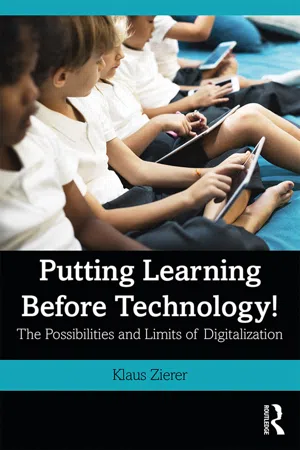![]()
Chapter 1 Digitalization between euphoria and apocalypse
Task for reflection
Reflect on what you already know about digitalization: What domains can you name in which digitalization is sparking a revolution? What domains can you name in which digitalization is falling short of the expectations originally placed in it? And how much importance do you attach to digitalization in education?
Goals
This chapter attempts to characterize digitalization as a focal point of public discourse. It describes the standpoints of those who are highly optimistic about digitalization as well as those who see digitalization more as a threat than a blessing. When you finish reading this chapter, you should be able to answer the following questions:
- What is the meaning of the term “digital natives,” and what is the distinguishing feature of this generation?
- Is it legitimate to speak of a revolution in view of the developments in hardware and software in the past 10 to 20 years?
- What threats does digitalization pose for processes of learning and development?
- What is the current state of our knowledge about the possible effects of digitalization on human health?
- How digitized is our lifeworld?
- What conclusions does this allow us to draw for digitalization in education?
Promoting digitalization in all societal domains is currently among the top political priorities around the world. In a 2016 interview with talk show host Anne Will, for example, German Chancellor Angela Merkel stated that she had chosen digitalization as one of the key issues of her next term. It makes no difference what sector one is talking about—trade and industry, politics and administration, health and medicine, science and innovation, or school and instruction. The argumentation is the same in every case: Digitalization is a challenge for the future, and everyone is afraid of missing the boat.
This is of course also true of educational policy. The task of getting schools connected to the internet and equipping them with the necessary modern technology is on the agenda of every political party. One would be hard pressed to find a ministry of education anywhere on earth that has not launched an initiative in this area. In the German-speaking world, for instance, such proposals go by names like “media offensive,” “learning 2.0,” and “digital revolution.” An initiative proposed in 2016 by the German Federal Minister of Education and Research Johanna Wanka has a similar thrust: It involves investing five billion euros to help turn 40,000 schools into digital learning institutions in the next five years. Although the funding was not yet available at the time the proposal was launched, this stance on digitalization was and remains a part of the political agenda.
For many, digitalization therefore constitutes the key step in the process of taking education and training into a new millennium. And yet it is not even clear what is meant by “digitalization.” In public discourse the use of the term is imprecise, serving as a collective name for a number of recent technological developments: Is learning with a computer already digital learning, or does it have to be done on a tablet? Does work with interactive whiteboards count? And what about pocket calculators?
It is this lack of precision that makes the term “digitalization” seem appropriate for this book. After all, the technological developments of the past decades—the radio, the overhead projector, the pocket calculator, the tape recorder, the television, the interactive whiteboard, the smartphone, or the tablet computer—all have one thing in common: Opinions on them in public discourse oscillate between euphoria and apocalypse.
The associated hype surrounding “digital learning” is being driven by influential mass media, which invoke threatening scenarios time and again: The 47th issue of Die Zeit from the year 2014 proclaimed that “the digital world ends at the school gate,” Spiegel Online from 12 December of the same year bemoaned “teachers without a connection,” and as early as late October 2010 Focus Online asserted that “teachers are neglecting new media.” The message is clear: Only by giving digital learning top priority in the classroom is it possible to conduct modern and successful educational work.
This reporting on educational policy makes a good many teachers feel as if they have their backs to the wall. They are worried, sometimes even afraid, that they have missed something and that they are doing a lot of things wrong. It will be a great comfort for these teachers to hear the critics who are less enthusiastic about digitalization. Besides, a closer look at these positions reveals that, in reality, quite a few of the promises made in the euphoria surrounding digitalization do not live up to expectations. Against this backdrop, it is no wonder that the pendulum in the discussion then rapidly swings back in the direction of a digitalization apocalypse. So what threads can we find in this conflict? What are the main messages, and how is it possible to resolve the tension between these two extremes?
As a means of finding an answer to these questions, I would like to present several theses and antitheses on digitalization in education in the following. Although the selection is by no means exhaustive, it does serve to reveal the scope of the discussion and the vehemence with which it is being conducted. In conclusion, I will attempt to bring the two views together in the form of a synthesis.
Thesis: Today’s children are digital natives
It is one of the most common arguments advanced in the conflict between opponents and advocates of digitalization: The children and youths of today are digital natives. This thesis has been formulated by Marc Prensky (2010) among others and is uncontroversial at the following level: Children and youths now grow up in a world in which digitalization is a permanent fixture. Every household is equipped not just with radios, televisions, and telephones but also with computers, smartphones, and tablets. The use of new media and the internet is perfectly natural for both parents and their children, yet while the former have had to acquaint themselves with these technologies in the course of their lives, the latter were confronted with them from the time they were born. The theory of digital natives goes even further: First, it argues that older generations are in danger of becoming digital immigrants. Teachers in particular are at risk, because they cannot keep abreast of the experiences of the digital natives and are therefore not in the position to design learning processes for them. Second, this leads to the conclusion that learning itself has changed for digital natives. These two implications are untenable from an educational science perspective, as will be explained below. In the following, I would therefore like to take a look at the lifeworld of the digital natives, which has indeed changed (cf., on the following, Bundesministerium für Familie, Senioren, Frauen und Jugend, 2017).
One of the most important characteristics of the digitalization of a lifeworld is the dichotomy between freedom and necessity. On the one hand, digitalization enables us to overcome space and time and communicate with people at all times and in all places. The boundaries between space and time seem to disappear. Yet on the other hand, digitalization forces us to give up this freedom again: Being reachable everywhere and connected with many people also means being available all the time and everywhere. This makes digital communication and networking into a characteristic feature of childhood and youth, if not the most characteristic feature of all, and it should come as no surprise that companies see this feature as a market to exploit. As a consequence, nearly 100 percent of 12- to 25-year-olds now have their own smartphone and use it nearly every day to get on the internet. Youths themselves state that they use the internet for a variety of purposes. However, the amount of time they spend searching for information is negligible compared to the amount they spend on the areas of “entertainment” and “games,” and they spend the most time of all by a wide margin on communication. Bearing in mind that youths have nearly 300 social contacts of this kind, it is evident how much their lifeworld has changed on account of digitalization and how the task of discovering one’s identity has changed as a result (cf. Montag, 2018)—I will only allude to possible dangers here, such as cybermobbing, misuse of data, and manipulation.
Thesis: Today’s hardware and software are revolutionary
The state of technological development has advanced at lightning pace in recent decades. As an example from the domain of computer technology, take the Zuse Z3, a wonder computer in its time that took up an entire room and was so expensive hardly anyone could afford it, and compare it with an ordinary laptop computer that can be purchased today at a relatively low price and taken along everywhere one goes.
Just as the speed of technological development has accelerated, the amount of time it takes for technological innovations to be adopted has shortened. Whereas the radio needed several decades to become accepted and used by most people, the television only needed a single decade, the internet no more than a few years, and new apps need just a few weeks or months to conquer the market. Each of these innovations has the potential to unleash new possibilities for communicating and interacting.
Hence, the rate of change is increasing—and at such a pace that innovation cycles n...


